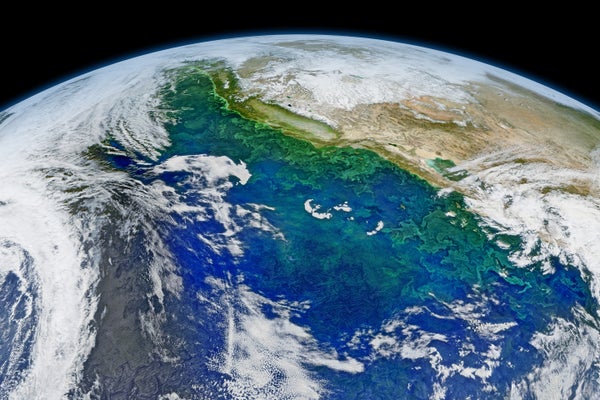September 12, 2024
4 min read
Scientists Will Make Oceans Absorb More Carbon Dioxide
A research consortium plans to revive geoengineering trials of a controversial iron fertilization technique to pull carbon dioxide from the air, despite public backlash.

This February 8, 2016 composite image shows the complex distribution of phytoplankton in one of the eastern boundaries of Earth’s upwelling system — the California Current.
NASA/Goddard/Finland-NPP/VIIRS
Scientists plan to plant iron in part of the Pacific Ocean to trigger a bloom on the surface of phytoplankton that would have absorbed carbon dioxide from the air, reviving field tests of a geoengineering technique that has been banned more than a decade.
On September 9, 23 academics from Exploring Ocean Iron Solutions (ExOIS), a not-for-profit, noncommercial consortium, laid out the program in Climate Boundaries to assess iron fertilization. The researchers wanted to better quantify how much CO2 this method can sequester in the deep sea and what effect it can have on the marine ecosystem. They hope to begin tests in 10,000 square kilometers of the northeastern Pacific Ocean as soon as 2026, said consortium member Ken Buesseler of the Woods Hole Oceanographic Institution.
The Intergovernmental Panel on Climate Change says the world will likely need to remove billions of metric tons of atmospheric CO.2 to limit global warming to 1.5 degrees Celsius (2.7 degrees Fahrenheit), and Buesseler said fertilization could be “one of the pieces of that puzzle.” The ocean already contains more carbon than Earth’s plants, crops and soil, he says, and it has the capacity to hold more. The spread of iron, he added, could “accelerate” the natural biological carbon pump by promoting more phytoplankton growth.
In support of science journalism
If you enjoyed this article, consider supporting our award-winning journalism by subscribing. By purchasing a subscription, you help to ensure a future of influential stories about the discoveries and ideas that shape our world today.
During photosynthesis, phytoplankton consume CO2sunlight and nutrients, including iron. But in many parts of the ocean, this element is rare. If some are delivered to these areas by wind-blown dust or volcanic ash—or by a ship deliberately pumping iron sulfate solution—huge numbers of microscopic organisms can rapidly grow and multiply. When these creatures die or are eaten and released by larger animals, some of the carbon they take up sinks into deep, slow-moving waters as “marine snow,” keeping the carbon out of the atmosphere for decades. or century.
ExOIS is seeking to raise $160 million for the entire program. To begin with, the scientists received a $2-million grant from the National Oceanic and Atmospheric Administration for computer modeling, and they are in talks with potential donors such as the Ocean Resilience and Climate Alliance, a philanthropic coalition funded by the billionaire Michael Bloomberg and others.
ExOIS plans to apply to the US Environmental Protection Agency for permission to conduct tests under the London Protocol, which in 2013 set an international ban on fertilizing iron in the ocean for commercial purposes. The convention allows fertilization for research if it is monitored and does not harm the environment.
Buesseler and others added iron to the ocean during a dozen experiments in the 1990s and 2000s. But a public backlash against tinkering with Earth’s natural systems emerged in 2012, after American businessman Russ George famously dumped 100 metric tons of iron dust on Canada’s coast, partly to boost salmon fishing.
ExOIS promises detailed monitoring of the effects of its field studies, as well as improved computer modeling of the implications. Scientists will add a nonreactive tracer such as sulfur hexafluoride to the iron sulfate solution, a step that will help track the spread of fertilized water as the iron sulfate slowly breaks down. They will measure CO2 concentration using ships, floats and underwater drones. And they will examine satellite images that may register an increase in the color of phytoplankton on the ocean surface. The group also promises more public engagement and consideration for environmental impacts than those involved in previous iron ore projects.
The effects can be varied and wide-ranging. In a 2009 experiment in the southwest Atlantic Ocean by German and Indian scientists, larger zooplankton ate smaller phytoplankton—and that little carbon actually reached the deep sea. In an experiment conducted in 2006 in the northeast Pacific by researchers in the US and Canada, toxic species of phytoplankton thrived. This has led to fears that fertilization could create “dead zones” where widespread algal blooms will consume all the oxygen in the water, cutting off other life. Phytoplankton blooms can also consume nutrients such as phosphorus and nitrogen that are then unavailable to organisms elsewhere, a phenomenon known as “nutrient robbing.” In addition, scientists still know very little about the deep-ocean ecosystems where carbon must be stored. “Probably [iron fertilization] affect something we don’t really understand yet,” said deep-sea expert Lisa Levin of the Scripps Institution of Oceanography, who is not involved in the ExOIS program.
Last year, a computer modeling study by British, American and French researchers found that adding one million to two million metric tons of steel to the ocean each year could release 45 billion metric tons of carbon by 2100. It will also steal nutrients from other marine life, however. Along with an estimated 15 percent reduction in marine biomass caused by warming, another 5 percent could be lost due to iron fertilization, particularly in fishing grounds near the Atlantic, Pacific and Indian coasts. “I’ve never really seen it [ExOIS] presents a hypothesis of what went wrong in previous work … that either made the carbon yield higher or minimized the negative consequences,” said Alessandro Tagliabue of the University of Liverpool in England, co-lead author of the study that.
Buesseler believes some tough trade-offs like this may be necessary. “It’s a small change in biology, associated with doing nothing and watching this planet boil over,” he said.
#Scientists #Oceans #Absorb #Carbon #Dioxide